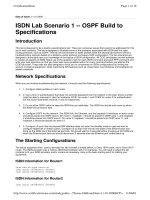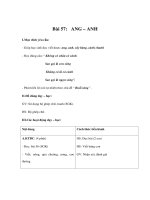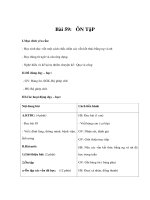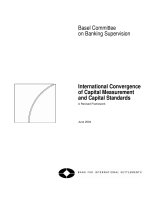Tài liệu OSPF Lab Scenario 1 - Classless and Discontiguous Networks pptx
Bạn đang xem bản rút gọn của tài liệu. Xem và tải ngay bản đầy đủ của tài liệu tại đây (21.15 KB, 3 trang )
CertificationZone Page 1 of 3
/?Issue=38&IssueDate=06-01-2001&CP= 11/06/01
Date of Issue: 06-01-2001
OSPF Lab Scenario 1 - Classless and
Discontiguous Networks
by Howard Berkowitz
Setup
Initial Configuration
OSPF Configuration Requirement
Solution
Example Configurations
Ginger
Oregano
Soy
Garlic
Sesame
Setup
Configure a set of five routers as shown above. All routers are to be in area 0.0.0.1. The yellow/solid medium needs
to be broadcast multiaccess. While it is shown as Ethernet, you may use any LAN technology available on your
routers.
The blue/dotted networks are point-to-point, so they can use any medium available on your routers. The red/parallel
line network is intended to be a stub network, so it can be defined on any medium or on a loopback. If you define it on
a loopback, be sure to use the specified prefix length.
Are there discontiguous networks or overlapping network ranges? Are they a problem? Why or why not? Fix them if
they are a problem.
Initial Configuration
Establish unique router IDs for each router, putting them on loopback interfaces. Do not yet configure OSPF.
Verify addresses and the formation of loopback addresses.
CertificationZone Page 2 of 3
/?Issue=38&IssueDate=06-01-2001&CP= 11/06/01
OSPF Configuration Requirement
On each router, create an OSPF process that puts each interface into area 0.0.0.1. I strongly recommend that you
have one network statement for each interface, but you can experiment with wildcards that put more than one
interface into OSPF. It is your choice whether to advertise the loopback subnets.
You may choose to enable OSPF debugging and watch the activity as OSPF initializes. With increasing numbers of
routers, you will have more and more debug traffic you have been warned! Simply record the traffic for later
analysis; it will go by too fast to review on the screen.
Troubleshoot any connectivity problems.
Observe the routing table that is built. Compare its entries to the general information shown in show ip ospf
database, and then to the more detailed information shown with the net and router keywords added to this
command. Experiment with the other OSPF display commands, remembering that many of them apply only to multi-
area domains.
Solution
You should have no problem with either discontiguous networks or overlapping ranges.
OSPF isn't even aware of classful networks, so discontiguous networks are a non-issue.
As long as you configure ip subnet-zero and follow strict CIDR/VLSM-style guidelines for "subnetting a subnet,"
you should have no problem with overlapping ranges as long as the same host address is not configured in more than
one subnet. The overlapping subnets will be distinguished in the routing table by their different masks.
Example Configurations
Ginger
hostname ginger
int loop 0
ip addr 192.168.255.1 255.255.255.0
int loop 1
ip addr 10.99.99.101 255.255.0.0
int e0
ip addr 172.17.1.1 255.255.255.0
router ospf 1
network 192.168.255.1 0.0.0.0 area 0.0.0.1
network 10.99.99.101 0.0.0.0 area 0.0.0.1
network 172.17.1.1 0.0.0.0 area 0.0.0.1
Oregano
hostname oregano
int loop 0
ip addr 192.168.254.1 255.255.255.0
int e0
ip addr 172.17.1.2 255.255.255.0
int s0
ip addr 172.16.1.1 255.255.255.252
router ospf 1
network 192.168.254.1 0.0.0.0 area 0.0.0.1
network 172.17.1.2 0.0.0.0 area 0.0.0.1
network 172.16.1.1 0.0.0.0 area 0.0.0.1
Soy
CertificationZone Page 3 of 3
/?Issue=38&IssueDate=06-01-2001&CP= 11/06/01
hostname soy
int loop 0
ip addr 192.168.253.1 255.255.255.0
int e0
ip addr 172.17.1.3 255.255.255.0
int loop 1
ip addr 172.16.2.1 255.255.255.0
router ospf 1
network 192.168.253.1 0.0.0.0 area 0.0.0.1
network 172.17.1.3 0.0.0.0 area 0.0.0.1
network 172.16.2.1 0.0.0.0 area 0.0.0.1
Garlic
hostname garlic
int loop 0
ip addr 192.168.252.1 255.255.255.0
int e0
ip addr 172.17.1.17 255.255.255.240
int s0
ip addr 172.16.1.2 255.255.255.252
router ospf 1
network 192.168.252.1 0.0.0.0 area 0.0.0.1
network 172.17.1.17 0.0.0.0 area 0.0.0.1
network 172.16.1.2 0.0.0.0 area 0.0.0.1
Sesame
hostname sesame
int loop 0
ip addr 192.168.251.1 255.255.255.0
int e0
ip addr 172.17.1.4 255.255.255.0
int e1
ip addr 172.17.1.18 255.255.255.240
router ospf 1
network 192.168.251.1 0.0.0.0 area 0.0.0.1
network 172.17.1.4 0.0.0.0 area 0.0.0.1
network 172.17.1.18 0.0.0.0 area 0.0.0.1
[IE-OSPF1-LS1-F03]
[2001-05-30-02]
Copyright © 2001 Genium Publishing Corporation









